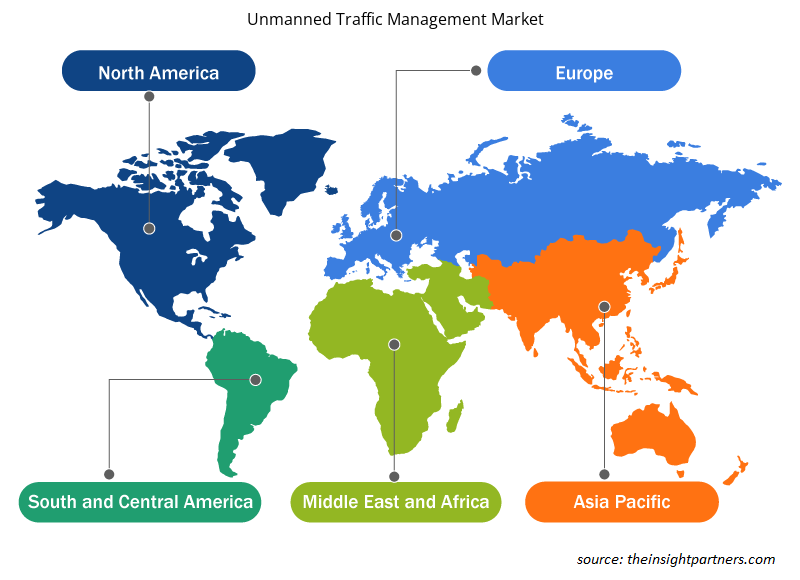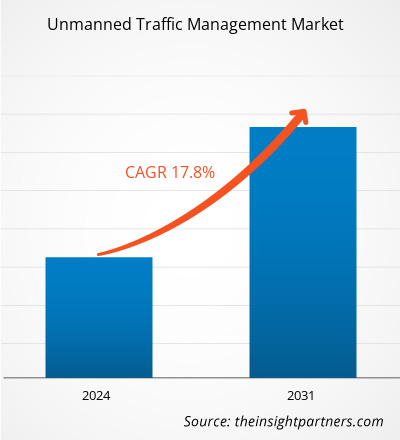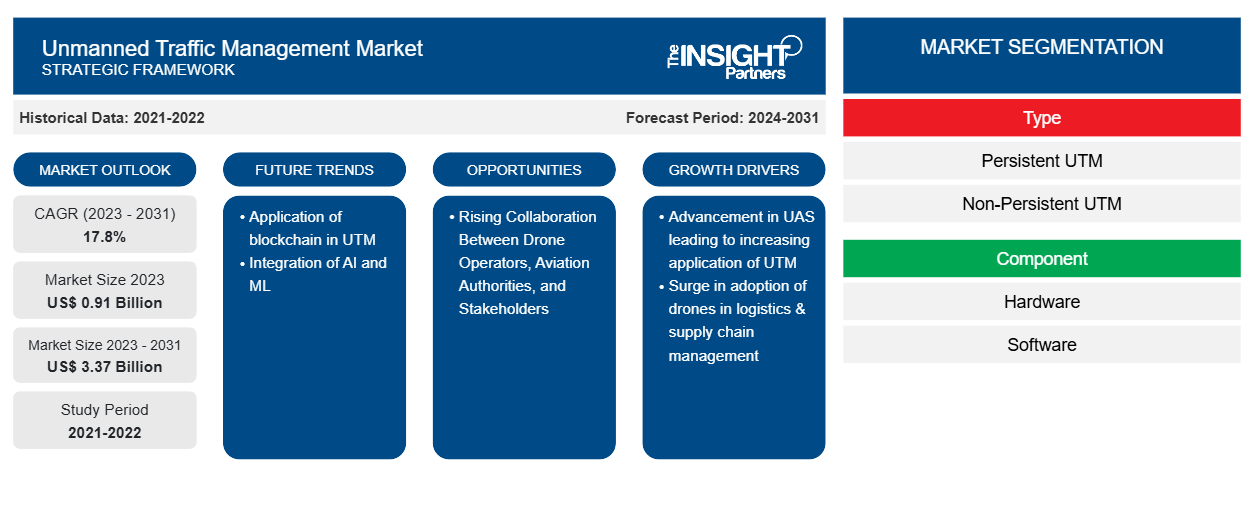Der Markt für unbemanntes Verkehrsmanagement soll von 0,91 Milliarden US-Dollar im Jahr 2023 auf 3,37 Milliarden US-Dollar im Jahr 2031 anwachsen. Der Markt wird zwischen 2023 und 2031 voraussichtlich eine durchschnittliche jährliche Wachstumsrate von 17,8 % verzeichnen. Die zunehmende Anwendung von Blockchain in UTM dürfte ein wichtiger Trend auf dem Markt bleiben.
Marktanalyse für unbemanntes Verkehrsmanagement
Strenge regulatorische Standards für die Herstellung von Produkten für unbemannte Verkehrsmanagementlösungen sind eine entscheidende Herausforderung für neue Marktteilnehmer. Verbindliche Vorschriften zur Einhaltung der Standards für die Kontrolle des Luftverkehrs haben eine potenzielle Herausforderung für neue Marktteilnehmer geschaffen. Somit ist es eine Eintrittsbarriere für neue Marktteilnehmer. Daher würde eine geringere Anzahl neuer Marktteilnehmer es den bestehenden Akteuren ermöglichen, einen starken potenziellen Anteil am Wettbewerbsmarkt zu halten. Diese Faktoren machen die Bedrohung für neue Marktteilnehmer also gering bis mäßig.
Marktübersicht für unbemanntes Verkehrsmanagement
Zu den wichtigsten Akteuren im globalen Ökosystem des Marktes für unbemanntes Verkehrsmanagement gehören Hardwarehersteller, Softwareentwickler, UTM-Systemanbieter und Endverbraucher. Hardwarehersteller sind die Systemhersteller, die sich mit der Entwicklung verschiedener Systemkomponenten wie Antennen, Kameras, Sensoren und mehr befassen. Mit der steigenden Nachfrage nach unbemanntem Verkehrsmanagement für den zunehmenden Luftverkehr, die auf die steigenden Verkäufe von Drohnen und UAS auf der ganzen Welt zurückzuführen ist, ergeben sich für UTM-Hersteller auch nachhaltige Wachstumschancen. Dann entwerfen Softwareentwickler Software, die die Plattform bietet, um alle Daten für die Entscheidungsfindung zu sammeln und zu visualisieren. Die UTM-Systemhersteller integrieren Software und Hardware in einem System. Einige der wichtigsten UTM-Systemanbieter sind Lockheed Martin Corp; Thales SA; Frequentis AG; Airbus SE; und Raytheon Technologies Corp (Collins Aerospace Systems). Diese UTM-Anbieter sind ständig damit beschäftigt, das unbemannte Verkehrsmanagement weiterzuentwickeln, damit es ordnungsgemäß funktioniert. Zu den wichtigsten Endverbrauchern des Marktes für unbemanntes Verkehrsmanagement gehören militärische und kommerzielle Flugbetreiber.
Passen Sie diesen Bericht Ihren Anforderungen an
Sie erhalten kostenlos individuelle Anpassungen an jedem Bericht, einschließlich Teilen dieses Berichts oder einer Analyse auf Länderebene, eines Excel-Datenpakets sowie tolle Angebote und Rabatte für Start-ups und Universitäten.
-
Holen Sie sich die wichtigsten Markttrends aus diesem Bericht.Dieses KOSTENLOSE Beispiel umfasst eine Datenanalyse von Markttrends bis hin zu Schätzungen und Prognosen.
Markttreiber und Chancen für unbemanntes Verkehrsmanagement
Starker Einsatz von Drohnen in Logistik und Supply Chain Management
Supply Chain Management (SCM) ist ein entscheidender Aspekt der meisten Unternehmen und kann sich direkt oder indirekt auf die Funktionsweise von Unternehmen auswirken. Mit der zunehmenden Verbreitung von Industrie 4.0 und der zunehmenden Integration von Geräten mit Internet der Dinge (IoT) in allen Geschäftsbereichen erlebt auch SCM eine zunehmende Technologieintegration. Zwar hat die Einführung von Technologie Auswirkungen, aber die Vorteile einer solchen Einführung überwiegen meist die Herausforderungen. Zu den Vorteilen gehören eine höhere Effizienz, geringere Betriebskosten und Datensicherheit. Mit der zunehmenden Verbreitung von Technologien gewinnen UAVs und UAS-Technologien aufgrund der gebotenen Vorteile in der Transport- und Logistikbranche an Bedeutung. Drohnen werden an verschiedenen Stellen einer Lieferkette eingesetzt , beispielsweise im Bestandsmanagement, bei der Verfolgung „verlorener“ Waren, beim Warentransport zwischen Lagern und bei der Zustellung auf der letzten Meile. Zu den relativ neueren Anwendungen von Drohnen gehören LKW-Drohnenkooperationen, die als parallele Multi-UAV-Zustellung bezeichnet werden und bei der Drohnen Lieferungen direkt vom Lieferwagen aus an mehrere Ziele durchführen. Die Entwicklung von Fracht-UAVs, die große Lasten über mehrere hundert Kilometer transportieren können, fördert den Einsatz von Drohnen in dieser Branche weiter. Im Juli 2022 kündigte Amazon.com, Inc. an, dass es plant, seinen Kunden in College Station, Texas, bis Ende 2022 Pakete per Drohne zuzustellen. Im Juni 2022 kündigte das Unternehmen seinen Plan an, einige Pakete in der nordkalifornischen Stadt Lockeford per Drohne auszuliefern. Diese Entwicklung hat das Wachstum des Marktes für unbemanntes Verkehrsmanagement vorangetrieben.
Zunehmende Zusammenarbeit zwischen Drohnenbetreibern, Luftfahrtbehörden und Interessengruppen
Drohnenbetreiber drängen auf die weitverbreitete Einführung unbemannter Fluggeräte, vor allem wegen der damit verbundenen Vorteile. Die Luftfahrtbehörden sind jedoch vorsichtig, was die Art und Weise des Einsatzes solcher Fluggeräte angeht. Forschungsorganisationen und -institute arbeiten mit beiden Parteien zusammen, um UTM zu entwickeln. Eine bessere Zusammenarbeit zwischen den verschiedenen Interessengruppen von UTM kann eine schnellere und sicherere kommerzielle Nutzung von Drohnen und UAVs gewährleisten. Mit zunehmendem Verständnis arbeiten alle Interessengruppen regelmäßig zusammen, um Vorschriften zu harmonisieren und einen Rechtsrahmen für den Einsatz von Drohnen in VLOS und BVLOS zu entwickeln.
Marktbericht zum unbemannten Verkehrsmanagement – Segmentierungsanalyse
Wichtige Segmente, die zur Ableitung der Marktanalyse für unbemanntes Verkehrsmanagement beigetragen haben, sind Typ, Komponente, Anwendung und Endbenutzer.
- Basierend auf dem Typ ist der Markt für unbemanntes Verkehrsmanagement in persistentes UTM und nicht persistentes UTM unterteilt. Das persistente UTM-Segment hatte im Jahr 2023 einen größeren Marktanteil.
- Basierend auf den Komponenten ist der Markt für unbemanntes Verkehrsmanagement in Hardware und Software unterteilt. Das Hardwaresegment hatte im Jahr 2023 einen größeren Marktanteil.
- Basierend auf der Anwendung ist der Markt für unbemanntes Verkehrsmanagement in Kommunikation, Navigation, Überwachung und Monitoring und andere unterteilt. Das Kommunikationssegment hatte im Jahr 2023 einen größeren Marktanteil.
- Basierend auf dem Endnutzer ist der Markt für unbemanntes Verkehrsmanagement in Landwirtschaft und Forstwirtschaft, Logistik und Transport, Überwachung und andere unterteilt. Das Segment Verteidigung und Strafverfolgung hatte im Jahr 2023 einen größeren Marktanteil.
Unbemanntes Verkehrsmanagement – Marktanteilsanalyse nach Geografie
Der geografische Umfang des Marktberichts zum unbemannten Verkehrsmanagement ist hauptsächlich in vier Regionen unterteilt: Nordamerika, Europa, Asien-Pazifik und Rest der Welt.
Nordamerika dominierte den Markt im Jahr 2023, gefolgt von Europa und dem asiatisch-pazifischen Raum. Darüber hinaus wird der asiatisch-pazifische Raum in den kommenden Jahren voraussichtlich die höchste durchschnittliche jährliche Wachstumsrate verzeichnen. Die USA dominierten den nordamerikanischen Markt für unbemanntes Verkehrsmanagement im Jahr 2023. Der Markt für unbemanntes Verkehrsmanagement wird in den USA voraussichtlich wachsen, da die Regierung in Florida, Idaho, Minnesota und South Dakota elf Arten von Gesetzen für den Einsatz von Drohnen erlassen hat, darunter die Erlaubnis zum Einsatz von Drohnen für Katastrophenschutzkräfte, einschließlich der Bekämpfung von Waldbränden. Außerdem haben Idaho und Minnesota Strafverfolgungsbehörden den Einsatz unbemannter Flugzeugsysteme (Drohnen) für bestimmte Zwecke gestattet, darunter die Rekonstruktion von Verkehrsunfällen, Such- und Rettungsmissionen und Schulungszwecke. Die US-Bundesstaaten haben Vorschriften für das Fliegen von Drohnen zur Verbesserung der Gesellschaft für verschiedene Anwendungen erlassen. Daher wird erwartet, dass die bevorstehenden Vorschriften für Drohnen zu einer Zunahme der Zahl unbemannter Fahrzeuge in der Luft führen werden, was die Nachfrage nach Verkehrsmanagementsystemen steigert und das Marktwachstum ankurbelt. Darüber hinaus tragen unterstützende staatliche Finanzierungsinitiativen weiter zum Marktwachstum im Land bei. So wird beispielsweise die Initiative Agility Prime der US Air Force im März 2021 die Flugerprobung und Zertifizierung von rund 20 verschiedenen eVTOL-Flugzeugen finanzieren, die an ihrem Programm „Air Race to Certification“ teilnehmen. Die Initiative Agility Prime stellt außerdem 257 Teams aus Kleinunternehmen, Universitäten und anderen gemeinnützigen Forschungseinrichtungen Mittel zur Verfügung, die sich mit der kurzfristigen Forschung und Entwicklung (F&E) von eVTOL beschäftigen. Somit beschleunigen solche Initiativen die Einführung unbemannter Luftfahrzeuge und treiben das Marktwachstum voran.
Regionale Einblicke in den Markt für unbemanntes Verkehrsmanagement
Die regionalen Trends und Faktoren, die den Markt für unbemanntes Verkehrsmanagement im Prognosezeitraum beeinflussen, wurden von den Analysten von Insight Partners ausführlich erläutert. In diesem Abschnitt werden auch Marktsegmente und Geografie für unbemanntes Verkehrsmanagement in Nordamerika, Europa, im asiatisch-pazifischen Raum, im Nahen Osten und Afrika sowie in Süd- und Mittelamerika erörtert.

- Erhalten Sie regionale Daten zum Markt für unbemanntes Verkehrsmanagement
Umfang des Marktberichts zum unbemannten Verkehrsmanagement
| Berichtsattribut | Details |
|---|---|
| Marktgröße im Jahr 2023 | 0,91 Milliarden US-Dollar |
| Marktgröße bis 2031 | 3,37 Milliarden US-Dollar |
| Globale CAGR (2023 - 2031) | 17,8 % |
| Historische Daten | 2021-2022 |
| Prognosezeitraum | 2024–2031 |
| Abgedeckte Segmente |
Nach Typ
|
| Abgedeckte Regionen und Länder |
Nordamerika
|
| Marktführer und wichtige Unternehmensprofile |
|
Dichte der Marktteilnehmer für unbemanntes Verkehrsmanagement: Die Auswirkungen auf die Geschäftsdynamik verstehen
Der Markt für unbemanntes Verkehrsmanagement wächst rasant, angetrieben durch die steigende Nachfrage der Endnutzer aufgrund von Faktoren wie sich entwickelnden Verbraucherpräferenzen, technologischen Fortschritten und einem größeren Bewusstsein für die Vorteile des Produkts. Mit steigender Nachfrage erweitern Unternehmen ihr Angebot, entwickeln Innovationen, um die Bedürfnisse der Verbraucher zu erfüllen, und nutzen neue Trends, was das Marktwachstum weiter ankurbelt.
Die Marktteilnehmerdichte bezieht sich auf die Verteilung der Firmen oder Unternehmen, die in einem bestimmten Markt oder einer bestimmten Branche tätig sind. Sie gibt an, wie viele Wettbewerber (Marktteilnehmer) in einem bestimmten Marktraum im Verhältnis zu seiner Größe oder seinem gesamten Marktwert präsent sind.
Die wichtigsten Unternehmen auf dem Markt für unbemanntes Verkehrsmanagement sind:
- Lockheed Martin Corporation
- Leonardo SpA
- Thales-Gruppe
- Raytheon Technologies Corporation
- Altitude Angel Ltd
- Frequentis AG
Haftungsausschluss : Die oben aufgeführten Unternehmen sind nicht in einer bestimmten Reihenfolge aufgeführt.

- Überblick über die wichtigsten Akteure auf dem Markt für unbemanntes Verkehrsmanagement
Marktnachrichten und aktuelle Entwicklungen zum unbemannten Verkehrsmanagement
Der Markt für unbemanntes Verkehrsmanagement wird durch die Erhebung qualitativer und quantitativer Daten nach Primär- und Sekundärforschung bewertet, die wichtige Unternehmensveröffentlichungen, Verbandsdaten und Datenbanken umfasst. Nachfolgend sind einige der Entwicklungen auf dem Markt für unbemanntes Verkehrsmanagement aufgeführt:
- Thales und Thaicom legen über Thaicoms Tochtergesellschaft, einen führenden asiatischen Satellitenbetreiber und Anbieter integrierter Satellitenkommunikation, die Grundlagen für ein Rahmenwerk für unbemanntes Verkehrsmanagement (UTM), um das Wachstum des Drohnen-Ökosystems in Thailand zu ermöglichen. (Quelle: Thales, Pressemitteilung, April 2024)
- CAL Analytics hat in Abstimmung mit dem Ohio Department of Transportation (ODOT) ein Flugverkehrsmanagementsystem für Drohnen in geringer Höhe eingeführt, um landesweite Operationen zu unterstützen. (Quelle: CAL Analytics, Pressemitteilung, März 2024)
Marktbericht zum unbemannten Verkehrsmanagement – Abdeckung und Ergebnisse
Der Bericht „Marktgröße und Prognose für unbemanntes Verkehrsmanagement (2021–2031)“ bietet eine detaillierte Analyse des Marktes, die die folgenden Bereiche abdeckt:
- Marktgröße und Prognose für unbemanntes Verkehrsmanagement auf globaler, regionaler und Länderebene für alle wichtigen Marktsegmente, die im Rahmen des Berichts abgedeckt sind
- Markttrends und Marktdynamiken für unbemanntes Verkehrsmanagement wie Treiber, Einschränkungen und wichtige Chancen
- Detaillierte Porter-Fünf-Kräfte-Analyse
- Marktanalyse für unbemanntes Verkehrsmanagement mit Blick auf wichtige Markttrends, globale und regionale Rahmenbedingungen, wichtige Akteure, Vorschriften und aktuelle Marktentwicklungen
- Branchenlandschaft und Wettbewerbsanalyse, einschließlich Marktkonzentration, Heatmap-Analyse, prominenten Akteuren und aktuellen Entwicklungen für den Markt für unbemanntes Verkehrsmanagement
- Detaillierte Firmenprofile
- Historische Analyse (2 Jahre), Basisjahr, Prognose (7 Jahre) mit CAGR
- PEST- und SWOT-Analyse
- Marktgröße Wert/Volumen – Global, Regional, Land
- Branchen- und Wettbewerbslandschaft
- Excel-Datensatz
Aktuelle Berichte
Verwandte Berichte
Erfahrungsberichte
Grund zum Kauf
- Fundierte Entscheidungsfindung
- Marktdynamik verstehen
- Wettbewerbsanalyse
- Kundeneinblicke
- Marktprognosen
- Risikominimierung
- Strategische Planung
- Investitionsbegründung
- Identifizierung neuer Märkte
- Verbesserung von Marketingstrategien
- Steigerung der Betriebseffizienz
- Anpassung an regulatorische Trends























 Kostenlose Probe anfordern für - Markt für unbemanntes Verkehrsmanagement
Kostenlose Probe anfordern für - Markt für unbemanntes Verkehrsmanagement